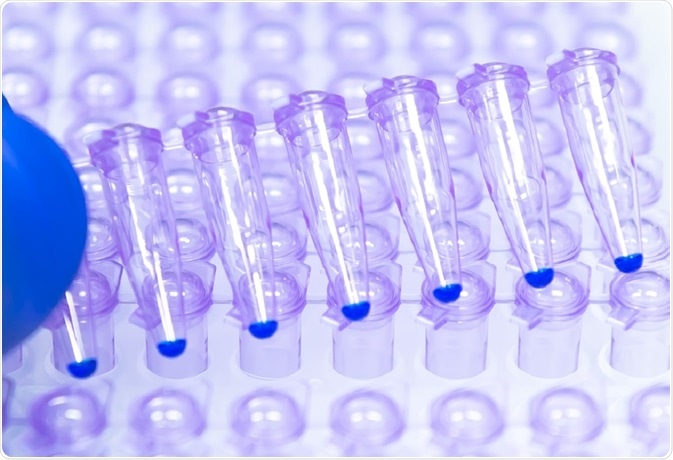Real-time quantitative polymerase chain reaction (PCR) is also known as qPCR. It is a lab technique that monitors the amplification of a target DNA molecule during PCR.

unoL | Shutterstock
What is real-time quantitative PCR?
qPCR uses one of two methods to detect the changes to DNA amplification: use of fluorescent dyes or sequence-specific DNA probes. qPCR is normally performed in a thermal cylinder that can illuminate each sample with a beam of light which causes fluorescence. The fluorescence emitted is then detected by a detector. The amount of DNA present can be quantified by the amount of fluorescence that is emitted.
qPCR methodology
qPCR is performed in a cycle. After the PCR solution (containing the DNA template, the fluorescent DNA primers, and the free nucleotide) is made, the cycle can be started:
- In the first step, the mixture is heated to approximately 95°C which separates the DNA into single strands by breaking the weak hydrogen bonds between the bases.
- In the second step, the temperature of the mixture is brought down to approximately 55°C which allows the DNA primers to bind to the DNA template strand.
- The third step involves heating the mixture back up to approximately 72°C, allowing the DNA to replicate following the primer by DNA polymerase.
- The fourth step involves bringing the temperature up to approximately 80°C for a few seconds to allow for the DNA amplification to be measured.
These four steps are repeated between 25 and 50 times, greatly amplifying the template strand, and giving quantitative data regarding the amplification. The temperature and timings for each step vary depending on the conditions used.
Uses of real-time quantitative PCR (RT-qPCR)
qPCR to detect Mycobacterium tuberculosis
Tuberculosis (TB) is a bacterial infection that is caused by Mycobacterium tuberculosis. This bacterium mainly affects the lungs, and an accurate diagnosis of M. tuberculosis is vital to treat and prevent TB.
A recent study aimed to discover if qPCR could be used to detect the presence of M. tuberculosis from the pulmonary and non-pulmonary tissue discovered that qPCR has a high sensitivity for both pulmonary and non-pulmonary TB. This shows that qPCR could be used to assess for TB infections. The study also stated that the technique is more effective when paired with another diagnostic test as an ‘add-on’.
qPCR to detect gastrointestinal parasitic infections
Gastrointestinal (GI) infections are a huge problem for many regions of the world and control of these infections is very important. A recent study examined the effectiveness of qPCR to detect GI parasite infections.
During this study, species-specific primers were used to test for the presence of 20 common GI parasite in the stool of individuals. The performance of the qPCR examinations was tested against the performance of microscopy examination (which is the common technique used to assess for GI parasitic infections).
qPCR found more positive results and was more sensitive to the detection of parasites than the conventional microscopy examination, making it extremely useful for lab research and diagnosis of GI parasitic infections.
Conclusions and perspectives: RT-qPCR
The process of qPCR is very similar to the standard PCR method, which makes it easy to perform. qPCR provides more efficient ways to detect bacteria and parasites compared to existing methods. In the future, more efficient ways of its use may be discovered.